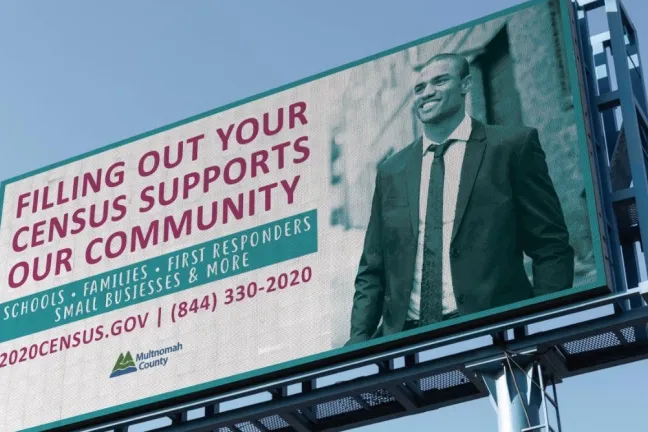Multnomah County residents self-responded to the 2020 U.S. Census at a rate of 73.7 percent--a 3.2 percent increase over the 2010 Census--in the midst of monumental challenges, according to leaders from Oregon’s Census delegation. Read the report .
The panel of experts and jurisdictional partners briefed the Board on the effort Tuesday, Dec. 1, delivering an update on participation and explaining next steps in the 2020 U.S. Census. The Census determines how nearly $900 billion in federal funding is allocated to Counties across the United States.
The results of the Census will influence the number of representatives each state has in the U.S. House of Representatives, and also informs the drawing of Congressional and state legislative districts. Lawmakers use the results of the Census to make critical decisions on healthcare, emergency preparedness, schools, parks, transportation, and more.
“During this pandemic, these services could not be more vital as we look at the future to plan our recovery,” said Commissioner Lori Stegmann, who led the effort to count all Multnomah County residents. “Many rely on our County services and counting as many people as possible helps us to deliver those services.”
Several factors made this year’s Census different from previous years. This year’s Census was the first that could be completed online. It was the first time Oregon launched a Complete Count Committee. It was also the first time Oregon set aside funding for reaching hard-to-count communities. And it faced several obstacles including the COVID-19 pandemic, an economic crisis, catastrophic wildfires, and frequently-changing operational timelines.
“The Census is always a challenging undertaking, but this one is without a doubt one for the history books and one where we had to make a number of adjustments to how we approached our work,” said Marc Czornij, Oregon’s liaison from the U.S. Census Bureau.
Reaching hard-to-count communities
Communities that historically are underrepresented in the U.S. Census are often among our most vulnerable populations. That includes Black, Latinx, Asian/Pacific Islanders, and Tribal and Native communities. Children under 5, rural residents, and people experiencing homelessness are also undercounted.
“From the beginning, it has been a priority of Oregon Gov. Kate Brown and our partners to center these communities in the 2020 Census to ensure an equitable count and ensure fair representation,” Sophorn Cheang from the Oregon Complete Count Committee said.
The State of Oregon set aside $7.5 million to reach underrepresented populations. Those funds went into field operations and media campaigns focused on hard-to-count residents. Organizers networked with local businesses and culturally specific partners.
When the COVID-19 pandemic hit, Census partners shifted from field work and in-person operations to digital outreach strategies and messaging through food distribution programming. Partners also invested in bus ads and billboards in hard-to-count ZIP codes and sent text messages to 106,000 individuals in those areas. They also engaged in mailings, culturally-specific communications, and radio.
“During the COVID era, direct contact with the community wasn’t an option,” said Adam Bristow, who helped lead Multnomah County’s Census effort. “We shifted our outreach which included digital outreach like the use of social media groups; community forums and apps; local markets; faith-based networks; and so much more.”
Organizers also combined community outreach with Census organizing. They delivered Census information through thousands of meals and food boxes via the Somali-American Council of Oregon, Immigrant & Refugee Community Organization, Meals on Wheels, and Bienestar de la Familia, Muslim Education Trust, Arab-American Council of Oregon, and other local partners.
This year’s Census also aimed to better reach residents experiencing homelessness. A new option allowed individuals to indicate they didn’t live at a physical address. And organizers did outreach in partnership with the Joint Office of Homeless and Services and the Salvation Army by serving 5,000 sacked lunches and developing community-specific information.
“We were attempting to navigate how to connect with people, and even further, how to motivate them to engage in an environment where communities were not only experiencing fear over their health, but were also exposed to divisive language from our national leadership,” said Layan Ammouri, who organized the Multnomah Complete Count efforts.
The road ahead
While the population of every state is supposed to be delivered to the President of the United States on Dec. 31, 2020, the Census Bureau has indicated that it will take longer this year. With the Presidential Inauguration taking place on Jan. 20, 2021, this could have significant implications.
Another deadline--March 31, 2021--may also be delayed by a few months. On that date, Census data is typically delivered to state legislatures and other officials. That data is used to draw state and congressional legislative districts.
Commissioners praised the Census effort and showed optimism for more federal funding and representation for Oregon in Congress.
“So much of what we do depends on meeting people where they’re at, and really effectively communicating and connecting with people that may be difficult and challenging to connect with,” Commissioner Sharon Meieran said. “And this is a hard enough challenge in the “before times,” but now it’s just more difficult by orders of magnitude.”
“I so appreciate the holistic approach in seeing that the work of the Census isn’t some separate project from the work of the County -- it is integral to the work of County,” Commissioner Susheela Jayapal said. “So to develop methods of doing the Census work that are closely tied to also delivering services, I think that’s perhaps the thing that I appreciate the most.”
“I think we did our part in seeing, making sure that we were counting the folks in the state that needed it, making sure that we showed up well for this,” Commissioner Jessica Vega Pederson said. “Hopefully it’s going to pay the dividends we are talking about in terms of federal dollars we need, in terms of representation that we are looking for in Congress.”

